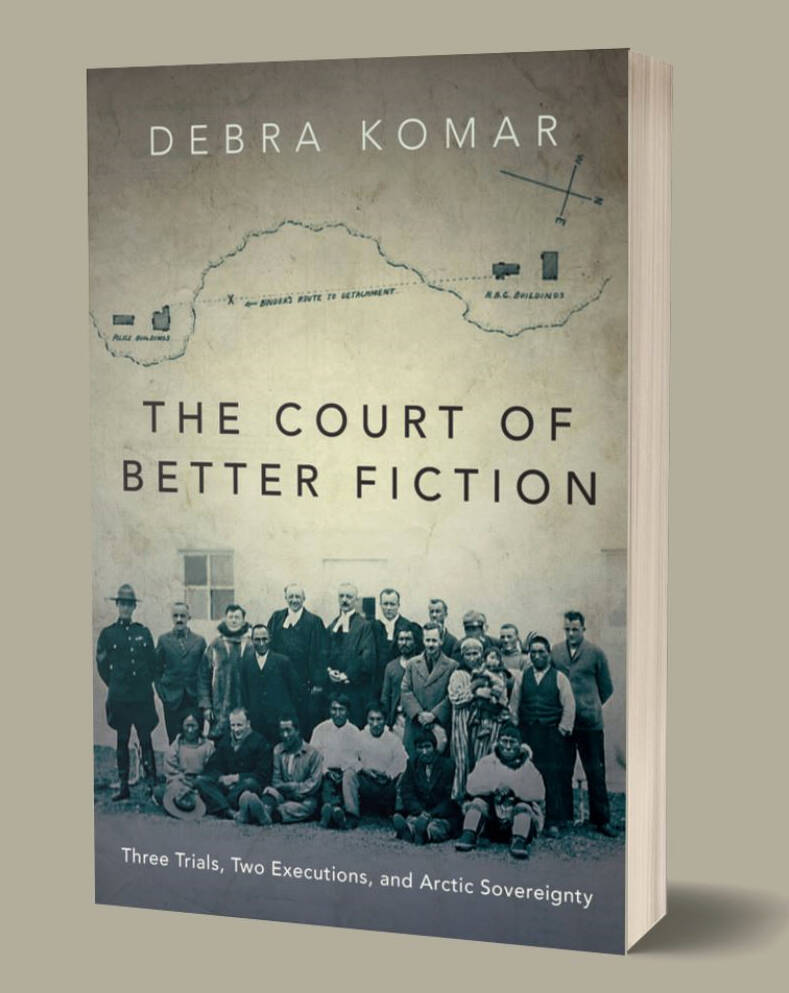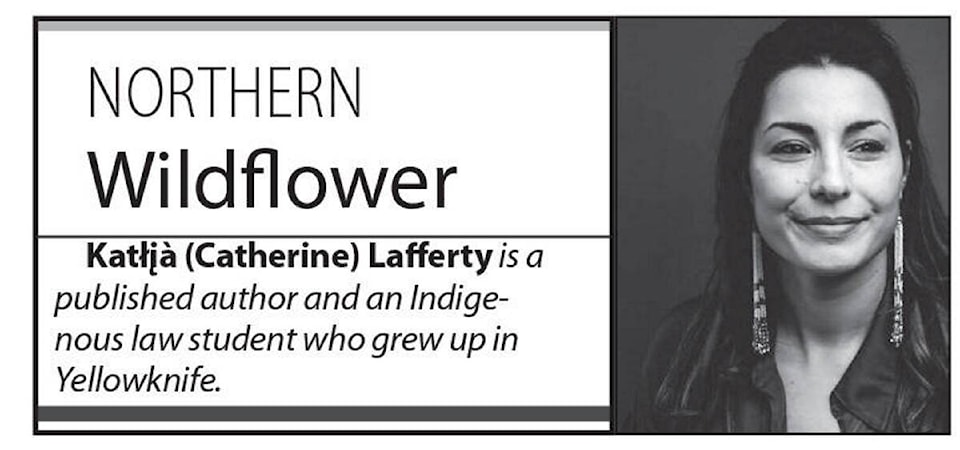The Court of Better Fiction, a book written by Debra Komar, critically examines the regulatory and professional failures of the judicial system in the 1920s.
This non-fiction book takes place in the NWT, before Nunavut was considered its own territory, in a place called Herschel Island where the trial for the murders of Corporal William Doak and Otto Binder, a trader clerk for the Hudson Bay, took place. The murders were said to be at the hands of two Inuit males, Tatamigana and Alikomiak, in the year 1922, at a time when there was no law enforcement presence in the area.
Komar describes the justice system of the time as a piecemeal abomination of bench law – derived from precedent rather than legislation – in which any judge’s decision became the nation’s governing principle.

The foundational significance of this case is that the Indian Act did not yet pertain to northern Indigenous populations, so only the common law could make a decision that was solely based on what Komar calls “mixed signals, paternalistic imperialism, and flawed reasoning.” The precedent that Komar refers to is the killing of two Oblate priests in 1913 by two Inuit men who were tried, with the possibility of a life sentence.
It was argued that they committed the murders in self-defence and that their cultural lifestyle had been disturbed by the priests and so they were acquitted of the charges and set free in the hopes that this mercy would be a firm warning to the Indigenous Peoples, which would potentially curb future violence towards non-Indigenous peoples by witnessing the power of Canadian law and spreading that message to the community once they returned from their short sentence.
However, once word got back to Ottawa about the killings of Doak and Binder, the prime minister at the time, Robert Borden, instructed the police to change their strategy and lay down the heavy arm of the law as an example wrote Komar. Not once did government officials stop and consider that the “Inuit had their own laws or system of justice, for such a notion was simply inconceivable. Even if the government were to concede that Indigenous law existed, it was easily ignored because it was…[not] written down,” wrote Komar.
The ethical implications of the trial began with the fact that not only was an all-white jury handpicked leaving no room for fairness or opportunity but officials rested on their laurels that there would be “sufficient white men to form a good jury,” said Komar. An Indigenous juror would not be selected to sit at trial in any court in Canada until nearly thirty years later in the late 50s. The second ethical breach was the appointment of defence counsel Thomas Cory, who had only eight months earlier written a strong letter to his superior indicating that the men who murdered Doak and Binder “should be hanged in a place where the natives will see and recognize the outcome of taking another’s life,” said Komar.
Cory would later be hired to represent those same men in court which is a direct conflict of interest and a breach of duty of loyalty as a legal professional. Another ethical red flag that arose and was ultimately ignored was the fact that the Northwest Territories Act did not allow for crimes to be prosecuted outside of its jurisdiction and the Department of Justice did not want to have to hold court there because of travel difficulty and difficult access to media so they quickly passed a bill to try and change that stipulation but the governor general did not ever sign it, which made the entire case illegitimate or at least the preliminary hearings, which were also flawed and invalid because they took place in the Yukon, explained Komar.
Legal officials themselves committed premeditation when they brought along the grave digger, Special Constable Gill, who brought with him supplies to set up the gallows, knowing there was a shortage of lumber out in the tundra for hanging the accused, said Komar. The graves were dug and the gallows were set up before the verdict was even given she thinks “as it was always assumed the trials would end with executions.”
Not wanting to wait a full year to send in a hangman they sent Gill in along with the other trial members, Komar added. All the while, Judge Dubac enjoyed his trip north tremendously, so much so that he didn’t spend frugally, said Komar. He enjoyed the local food, took photos of the landscape, hunted and fished with the locals, the jurors and even the accused, accompanying them on whale hunts and other culturally significant activities, Komar added.
These acts breach the very oaths of the duties that all parties signed onto. One juror in particular, Paul S. Porier, decided to publish and get paid to leak confidential information about the ongoing case and yet was not punished or held to account by the court, which is a failure to uphold their duty to punish public servants who breach the oath of confidentiality by way of a fine, imprisonment or both Komar deducts.
From the beginning to the end of this case language barriers prevailed, which in hindsight, raises questions about the alibi of the accused and the witnesses. For instance, the Inuit did not have the same concept of time as the white men. They did not use a clock but rather relied on the daylight and whether the sun was high or low in the sky to tell the time of day said Komar. The court did not take into consideration the belief systems of the Inuit in terms of what constitutes justice from their deeply spiritual perspective. Again, this is intercultural incompetence on the courts’ part, and it is sadly a systemic racial bias that still exists in today’s common law courts, albeit with exceptions to the rule where Indigenous legal orders are now regarded as law under the United Nations Declaration of the Rights of Indigenous Peoples.
In terms of due process, there is an extensive list of continuous dilemmas that seemed to be sorted out off the cuff and rationalized with poor excuses that were not validated by anyone but the men who were in charge of the proceedings. To name a few, no witness lists were given, no transcripts of the first trial were kept, called to testify, there was no discovery process, and there was no record of closing arguments, which is a violation of court procedure and the rules of law, the council for the defendant did not meet with his clients before trial, there was no concrete motive and no concrete evidence, there was no plea, during preliminary proceedings the accused were not represented by counsel all because the counsel “was not working in his clients’ best interests.” said Komar in her complete capture of ethical violations.
Perhaps the most surprising part of this case is that the accused were tried as adults and not the young offenders they were, being aged sixteen years or less and falling under the protection of the Juvenile Delinquents Act that was in place at the time, which states “youthful offenders should not be classed or dealt with as ordinary criminals.” wrote Komar. Further details of the evidence in question lead to the knowledge that forensic evidence did not match, there were no exhibits at trial, and no corpse, which raised the corpus delicti rule which “prohibits procession based solely on a defendant’s confession.”
If the element of the crime is not established by other means that ground for appeal would “lead to the vacating of a verdict,” explained Komar. This burden of proof was not dismissed by the defence in what is considered a “gross violation of criminal process” on not only the defence council but on the dept of justice and governor-general who expressed “indifference at best, willful malfeasance at worst,” Komar concluded.
In reading this book, I was constantly disappointed with the brazen trajectory of the outright rebellion of government officials in their blatant disregard for fulfilling the requirements under the law to ensure confidentiality, advocacy, duty of loyalty, cultural awareness, and access to justice all of which should have been provided to the accused. The court officials, in this case, worked together indiscreetly to ensure that the accused were found guilty and this undoubtedly resulted in prejudice. The numerous conflicts of interest and abhorrent overriding ethical standards did not hold in favour of the institute of justice. If this case were to play out in this day and age, there would be a tremendous backlash.
This historic account is a solemn reminder that common law was imposed on Indigenous peoples in Canada in an irresponsible manner and needs to be rectified through extensive and ongoing reconciliatory efforts.
